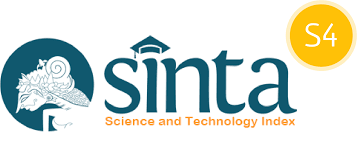Prediksi Tingkat Kesehatan Lingkungan Masyarakat Dalam Program Sustainable Development Goals Menggunakan Algoritma Naive Bayes
DOI:
https://doi.org/10.29408/jit.v6i2.18776Keywords:
Naïve Bayes Algorithm, Healthy Environment, SDGsAbstract
Indications of a decrease in the level of public awareness about protecting the environment have a direct effect on the urgent need for integrated environmental planning and management, so that the impact affects other aspects, such as the physical and socio-economic environment. The fact is that environmental damage is closely related to poverty and economic growth. In maintaining community environmental health and implementing the Sustainable Development Goals Program in East Lombok Regency, West Nusa Tenggara. Hamzanwadi University is working with the East Lombok Regency government to conduct sampling of the community with a total data of 4624 residents in ten sub-districts in the East Lombok Regency area. The purpose of this study is to help predict the level of public environmental health in the East Lombok region, the data will be classified and then processed using the Naïve Bayes algorithm with the multinomial naïve Bayes method. The results of testing the naïve Bayes algorithm after splitting the data five times, the best results were obtained, with the dataset divided by 20% testing data and 80% training data, an prediction value of 93.28% was obtained. The population environment in ten sub-districts in East Lombok Regency was classified as healthy
References
E. Khairina, E. P. Purnomo, and A. D. Malawnai, “Sustainable Development Goals: Kebijakan Berwawasan Lingkungan Guna Menjaga Ketahanan Lingkungan Di Kabupaten Bantul Daerah Istimewa Yogyakarta,” J. Ketahanan Nas., vol. 26, no. 2, p. 155, Sep. 2020, doi: 10.22146/jkn.52969.
M. Ridho Handoko, “SISTEM PAKAR DIAGNOSA PENYAKIT SELAMA KEHAMILAN MENGGUNAKAN METODE NAIVE BAYES BERBASIS WEB,” J. Teknol. dan Sist. Inf., vol. 2, no. 1, pp. 50–58, 2021, [Online]. Available: http://jim.teknokrat.ac.id/index.php/JTSI
H. Annur, “KLASIFIKASI MASYARAKAT MISKIN MENGGUNAKAN METODE NAÏVE BAYES,” 2018.
Y. Kuspandi Putra, “Analisis Perbandingan Pengaruh Pertumbuhan Ekonomi Terhadap Tingkat Kesejahteraan Masyarakat Pada Desa Suralaga Dengan Menggunakan Algoritma Naive Bayes Dan Support Vector Machine (Svm),” J. Inform. dan Teknol., vol. 4, no. 1, 2021, doi: 10.29408/jit.v4i1.2961.
M. Wasil, “Infotek : Jurnal Informatika dan Teknologi Analisis Persepsi Masyarakat Terhadap Kinerja Aparatur Desa Dalam Meningkatkan Pelayanan Publik Di Desa Lenek Lauk Menggunakan Metode Naive Bayes Pelayanan publik adalah kegiatan atau rangkaian kegiatan dalam ran,” vol. 3, no. 2, pp. 140–146, 2020.
A. I. Lubis, U. Erdiansyah, and R. Siregar, “Komparasi Akurasi Pada Naïve Bayes Dan Random Forest Dalam Klasifikasi Penyakit Liver Comparison of Accuracy in Naïve Bayes and Random Forests in Classification of Liver Disease.” [Online]. Available: www.jurnal.unimed.ac.id
D. Normawati and S. A. Prayogi, “Implementasi Naïve Bayes Classifier Dan Confusion Matrix Pada Analisis Sentimen Berbasis Teks Pada Twitter,” 2021.
V. Sari, F. Firdausi, and Y. Azhar, “Perbandingan Prediksi Kualitas Kopi Arabika dengan Menggunakan Algoritma SGD, Random Forest dan Naive Bayes,” Edumatic J. Pendidik. Inform., vol. 4, no. 2, pp. 1–9, 2020, doi: 10.29408/edumatic.v4i2.2202.
Y. S. Sari, “Penerapan Metode Naïve Bayes Untuk Mengetahui Kualitas Air Di Jakarta,” J. Ilm. FIFO, vol. 13, no. 2, p. 222, 2021, doi: 10.22441/fifo.2021.v13i2.010.
Y. Yahya and H. Bahtiar, “Pengaruh Pertumbuhan Ekonomi Terhadap Tingkat Kesejahteraan Masyarakat Kecamatan Selong Kabupaten Lombok Timur – Nusa Tenggara Barat Menggunakan Algoritma Naive Bayes,” Infotek J. Inform. dan Teknol., vol. 4, no. 1, pp. 20–28, 2021, doi: 10.29408/jit.v4i1.2981.
W. P. Nurmayanti, “Penerapan Naive Bayes dalam Mengklasifikasikan Masyarakat Miskin di Desa Lepak,” Geodika J. Kaji. Ilmu dan Pendidik. Geogr., vol. 5, no. 1, pp. 123–132, 2021, doi: 10.29408/geodika.v5i1.3430.
M. Julkarnain and K. R. Ananda, “Sistem Informasi Pengolahan Data Ternak Unit Pelaksana,” Jinteks, vol. 2, no. 1, pp. 32–39, 2020.
M. T. H. Bunga, B. S, Djahi, and Y. Y. Nabuasa, “Multinomial Naive Bayes Untuk Klasifikasi Status Kredit Mitra Binaan Di Pt . Angkasa Pura I Program Kemitraan,” J-Icon, vol. 6, no. 2, pp. 30–34, 2018,
Karsito and Susanti Santi, “Klasifikasi Kelayakan Peserta Pengajuan Kredit Rumah Dengan Algoritma Naive Bayes Di Perumahan Azzura Residence,” J. Teknol. Pelita Bangsa, vol. 9, pp. 43–48, 2019.
M. Vishwakarma and N. Kesswani, “A new two-phase intrusion detection system with Naïve Bayes machine learning for data classification and elliptic envelop method for anomaly detection,” Decis. Anal. J., vol. 7, no. April, p. 100233, 2023, doi: 10.1016/j.dajour.2023.100233.
Downloads
Published
How to Cite
Issue
Section
License
Semua tulisan pada jurnal ini menjadi tanggung jawab penuh penulis. Jurnal Infotek memberikan akses terbuka terhadap siapapun agar informasi dan temuan pada artikel tersebut bermanfaat bagi semua orang. Jurnal Infotek ini dapat diakses dan diunduh secara gratis, tanpa dipungut biaya sesuai dengan lisense creative commons yang digunakan.
Jurnal Infotek is licensed under a Creative Commons Attribution 4.0 International License.
Statistik Pengunjung




